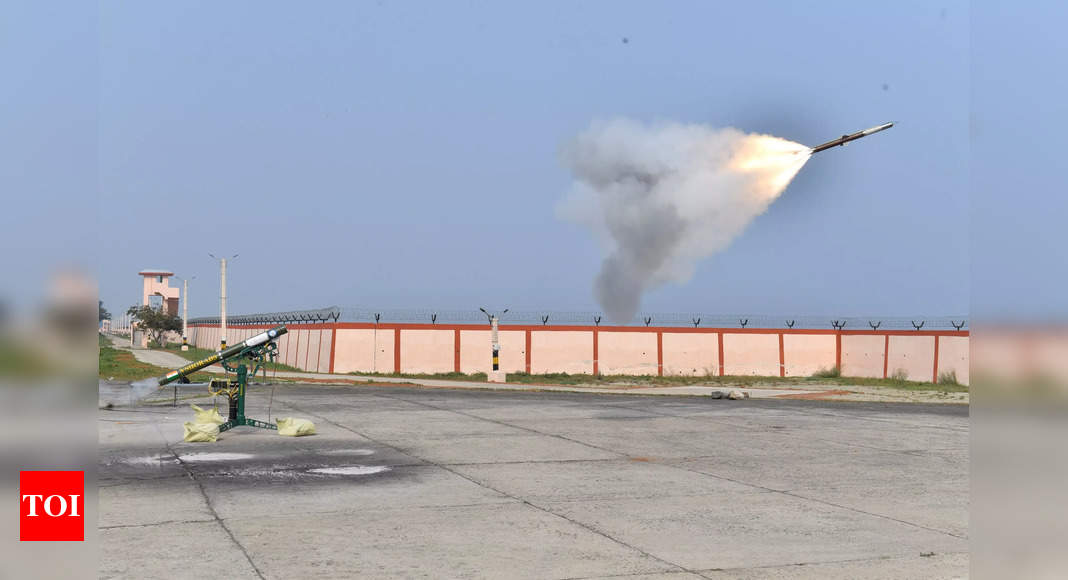
[ad_1]
NEW DELHI: India conducted two successful tests of its indigenous man-portable air defence missile system, designed to destroy hostile aircraft, drones and helicopters at very short ranges, on Wednesday and Thursday.
DRDO conducted flight tests of the very short-range air defence system (VSHORADS) missiles, which has a range of up to 6-km, from a ground-based portable launcher from the Integrated Test Range, Chandipur, off the Odisha coast.
“These tests were carried out against high-speed unmanned aerial targets under different interception scenarios. During all the test flights, the targets were intercepted and destroyed by the missiles, meeting the mission objectives,” an official said.
VSHORADS has been designed and developed by the Research Centre Imarat (RCI) in collaboration with other DRDO laboratories and Indian industry partners.
“VSHORADAS missile incorporates many novel technologies, including miniaturized reaction control systems and integrated avionics which have been successfully proven during the tests,” he said.
“The missile, propelled by a dual-thrust solid motor, is meant for neutralizing low-altitude aerial threats at short ranges. The design of the missile including launcher has been highly optimized to ensure easy portability,” he added.
Congratulating DRDO, Army and the industry involved in the successful development trials, defence minister Rajnath Singh said this new missile equipped with modern technologies will give further technological boost to the armed forces.
The Rajnath Singh-led defence acquisitions council in January last year had accorded “acceptance of necessity” for procurement of the infrared homing VSHORADS missiles under design and development by DRDO at a cost of Rs 1,920 crore, as was earlier reported by TOI.
In the interim, the armed forces are inducting a limited number of similar Russian systems to plug operational gaps in the continuing military confrontation with China in eastern Ladakh.
The Army and IAF have inked some deals under emergency procurement provisions for a limited number of Russian Igla-S MANPADS over the past three years. The last such contract for 100 Igla-S missiles and 48 launchers was inked by the Army in May last year. While the Army and IAF have the old Igla-1M systems since 1989, the Igla-S is an improved variant with a longer interception range of up to 6-km.
DRDO conducted flight tests of the very short-range air defence system (VSHORADS) missiles, which has a range of up to 6-km, from a ground-based portable launcher from the Integrated Test Range, Chandipur, off the Odisha coast.
“These tests were carried out against high-speed unmanned aerial targets under different interception scenarios. During all the test flights, the targets were intercepted and destroyed by the missiles, meeting the mission objectives,” an official said.
VSHORADS has been designed and developed by the Research Centre Imarat (RCI) in collaboration with other DRDO laboratories and Indian industry partners.
“VSHORADAS missile incorporates many novel technologies, including miniaturized reaction control systems and integrated avionics which have been successfully proven during the tests,” he said.
“The missile, propelled by a dual-thrust solid motor, is meant for neutralizing low-altitude aerial threats at short ranges. The design of the missile including launcher has been highly optimized to ensure easy portability,” he added.
Congratulating DRDO, Army and the industry involved in the successful development trials, defence minister Rajnath Singh said this new missile equipped with modern technologies will give further technological boost to the armed forces.
The Rajnath Singh-led defence acquisitions council in January last year had accorded “acceptance of necessity” for procurement of the infrared homing VSHORADS missiles under design and development by DRDO at a cost of Rs 1,920 crore, as was earlier reported by TOI.
In the interim, the armed forces are inducting a limited number of similar Russian systems to plug operational gaps in the continuing military confrontation with China in eastern Ladakh.
The Army and IAF have inked some deals under emergency procurement provisions for a limited number of Russian Igla-S MANPADS over the past three years. The last such contract for 100 Igla-S missiles and 48 launchers was inked by the Army in May last year. While the Army and IAF have the old Igla-1M systems since 1989, the Igla-S is an improved variant with a longer interception range of up to 6-km.
[ad_2]
Source link








